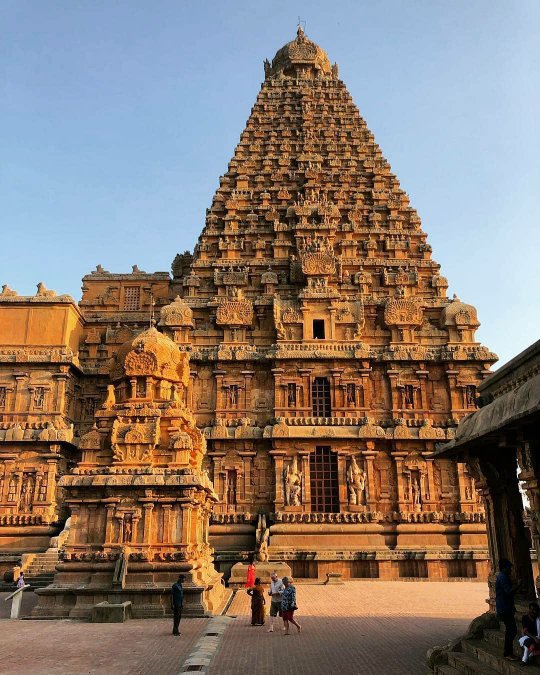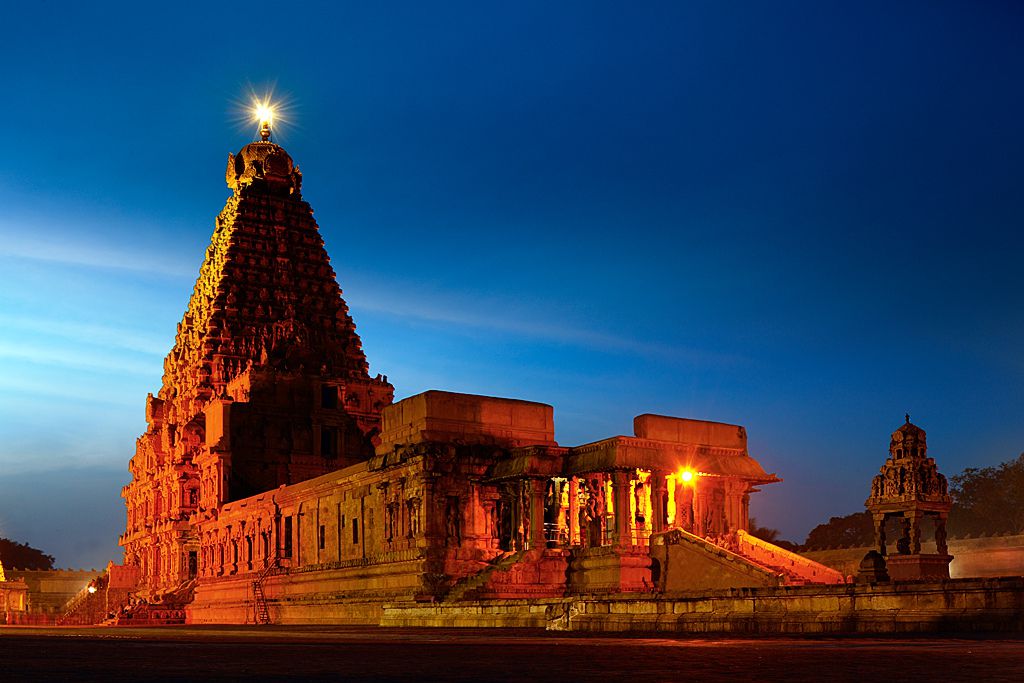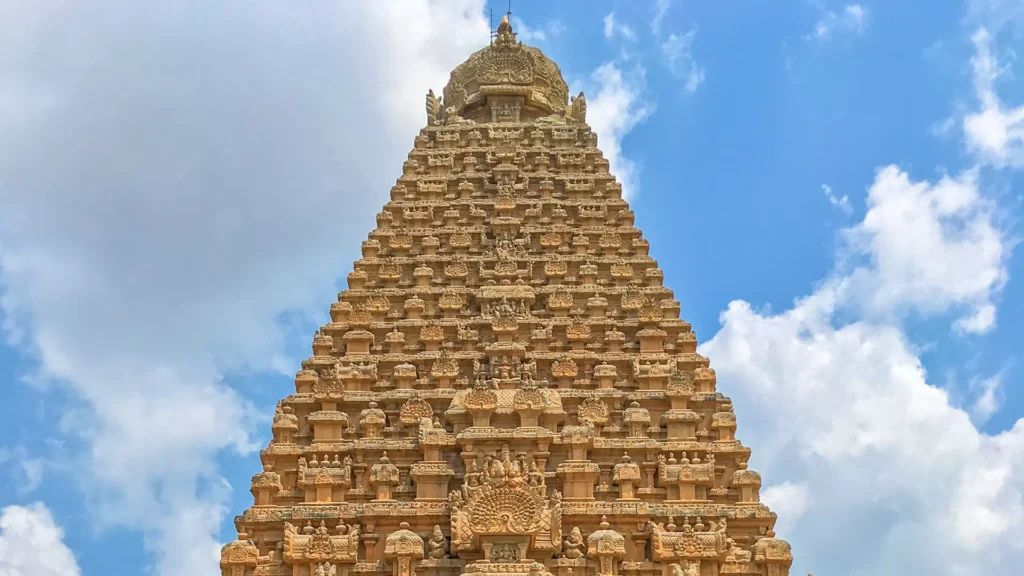
Brihadeeswara Temple
The Brihadeeswara Temple, also known as the Periya Kovil or Rajarajeswaram, stands tall as a testament to the grandeur of ancient Indian architecture. Situated in Thanjavur, Tamil Nadu, it is one of the most revered and iconic temples in India. This architectural marvel, dedicated to Lord Shiva, is a symbol of the great Chola dynasty’s legacy and serves as a beacon of India’s rich cultural heritage.
In this blog, we’ll take a deep dive into the history, significance, architectural brilliance, and the unmatched beauty of the Brihadeeswara Temple. Whether you are an avid history enthusiast, a spiritual seeker, or a lover of architectural marvels, this blog will offer you everything you need to know about this incredible monument.
Introduction to the Brihadeeswara Temple
The Brihadeeswara Temple was built during the reign of Rajaraja Chola I, the greatest ruler of the Chola dynasty, around the 11th century AD. It is located in the city of Thanjavur, which was once the capital of the Chola Empire. The temple is an architectural masterpiece and one of the largest in India, dedicated to Lord Shiva in the form of Rajarajeswarar.
The temple is not just an active place of worship; it also stands as a symbol of the zenith of Tamil culture, art, and engineering. It was constructed between 1003 and 1010 AD and is one of the most remarkable feats of Dravidian architecture. The temple is recognized as a UNESCO World Heritage Site and is an iconic structure that draws millions of visitors from across the globe.
A Peek into the History of Brihadeeswara Temple
The Chola Dynasty and Rajaraja Chola I
The history of the Brihadeeswara Temple is closely tied to the reign of Rajaraja Chola I, who was a visionary ruler known for his military prowess and contributions to Tamil culture. Rajaraja Chola was determined to build a grand temple dedicated to Lord Shiva to showcase the power of the Chola dynasty.
Rajaraja Chola’s reign was a period of remarkable cultural and architectural advancements. The Chola dynasty had already gained power over a significant part of South India, and the Brihadeeswara Temple was a symbol of the dynasty’s supremacy. It is said that Rajaraja Chola wanted the temple to not only serve as a place of worship but also as an embodiment of his devotion to Lord Shiva and his own imperial power.
The Construction of the Temple
The construction of the Brihadeeswara Temple was no small feat. It took over 6 years to complete, under the supervision of skilled architects and artisans from across the empire. The temple was built with the finest materials available during the time, such as granite and sandstone. It is believed that more than 1,000 elephants were used to carry the massive stones that were required for construction.
The temple’s completion was a remarkable achievement, given the technological limitations of the time. Its grandeur continues to astonish historians, architects, and visitors to this day.
Architectural Marvel of Brihadeeswara Temple
The Brihadeeswara Temple stands as an iconic example of Dravidian architecture. Every element of its structure showcases the brilliance of the Chola dynasty and the detailed artistry of its creators. Here are the main architectural features of the temple:
The Vimana (Temple Tower)
The most striking feature of the Brihadeeswara Temple is its towering Vimana (temple tower). Standing at an impressive height of 66 meters (216 feet), it is one of the tallest in India. The Vimana is built to resemble a pyramid and is crowned with a massive granite dome that is said to weigh around 80 tons. It is a feat of engineering, as the dome was constructed without the use of modern cranes.
The Vimana is adorned with intricate carvings, and the towering structure gives the temple its signature visual appeal. It rises above the temple complex, symbolizing the divine presence of Lord Shiva. The tower is also one of the tallest structures of its kind in the world, drawing admiration for both its scale and beauty.
The Main Sanctum (Garbhagriha)
The inner sanctum of the Brihadeeswara Temple, also known as Garbhagriha, houses the Shivalinga—a symbolic representation of Lord Shiva. The sanctum is small, dark, and mysterious, contributing to the serene and spiritual atmosphere of the temple. This central chamber is where the most important rituals take place.
The Shivalinga inside the sanctum is made of granite and stands majestically at the center of the temple. It is said to be one of the largest of its kind in India, measuring 3.7 meters (12 feet) in height and 6.5 meters (21 feet) in circumference.
The Prakara (Outer Courtyard)
The outer courtyard, also known as the Prakara, is a vast expanse that houses a series of smaller shrines and mandapams (halls) dedicated to various deities and saints. The architecture of the courtyard is symmetrical, with beautifully carved pillars and intricately designed bas-reliefs. Visitors often walk around the inner sanctum in a clockwise direction, paying homage to Lord Shiva and the other deities housed in the smaller shrines.
The outer courtyard also includes a large Nandi statue (the sacred bull of Lord Shiva), which is positioned facing the main sanctum. This massive statue, made of a single stone, is another remarkable feature of the temple. It is one of the largest Nandi statues in India and is a significant part of the temple’s aesthetic appeal.
The Temple’s Sculptural Beauty
The Brihadeeswara Temple is renowned for its beautiful and intricate carvings. The walls of the temple are adorned with sculptures that depict various scenes from Hindu mythology, including stories from the Ramayana, Mahabharata, and Shiva Purana. These carvings are a testament to the skill and artistry of the Chola artisans who created them.
The pillars of the temple are equally stunning, with detailed carvings of divine beings, celestial dancers, and mythical creatures. These sculptures not only add to the temple’s artistic grandeur but also serve to narrate the rich spiritual heritage of the region.
The Massive Nandi and Its Symbolism
As mentioned earlier, the Nandi statue at the Brihadeeswara Temple is an impressive and symbolic feature. This stone Nandi is positioned outside the main sanctum, looking towards the temple. It symbolizes strength, devotion, and loyalty to Lord Shiva.
The Nandi statue measures about 6 meters (20 feet) in length and is carved from a single piece of granite. It stands as a guardian of the temple, and its presence is an integral part of the worship rituals, as devotees often offer prayers and seek blessings from this sacred bull.
Spiritual Significance of Brihadeeswara Temple
The Brihadeeswara Temple is not just an architectural wonder but also a spiritual center that attracts millions of pilgrims each year. Devotees visit the temple to seek Lord Shiva’s blessings and participate in various rituals and festivals.

The temple’s spiritual significance is intertwined with the Chola dynasty’s devotion to Lord Shiva. The kings and queens of the dynasty believed that their prosperity and power were directly linked to their devotion to the deity. Therefore, the construction of such an imposing temple was both a symbol of their piety and their imperial power.
Festivals Celebrated at Brihadeeswara Temple
The temple is the center of numerous religious festivals, with Mahashivaratri being the most significant. During this festival, thousands of devotees flock to the temple to offer prayers and seek blessings from Lord Shiva. The temple also celebrates other festivals like Navaratri, Panguni Uthiram, and Karthikai Deepam, which attract large crowds and contribute to the temple’s spiritual vibrancy.
A Place of Pilgrimage
The Brihadeeswara Temple remains one of the most important pilgrimage sites in India. It is often visited by devotees who seek peace, spiritual solace, and connection with Lord Shiva. The serene environment of the temple provides a perfect setting for meditation and prayer, making it an ideal destination for spiritual seekers.
Conclusion
The Brihadeeswara Temple is an unparalleled blend of history, architecture, and spirituality. From its towering Vimana to the intricate carvings on its walls, this temple remains a timeless symbol of India’s cultural heritage. It is a place where faith, art, and history come together to create something truly magnificent.
A visit to this iconic temple is an experience that allows you to connect with the deep-rooted traditions of India while marveling at the incredible architectural skills of the Chola dynasty. The Brihadeeswara Temple is not just a place of worship but also a masterpiece that continues to inspire awe in those who experience it.

Frequently Asked Questions (FAQs)
- Who built the Brihadeeswara Temple?
- The temple was built by Rajaraja Chola I during the Chola dynasty’s rule in the 11th century.
- Where is the Brihadeeswara Temple located?
- The temple is located in Thanjavur, Tamil Nadu, India.
- What is the significance of the Nandi statue in the Brihadeeswara Temple?
- The Nandi statue symbolizes strength, devotion, and loyalty to Lord Shiva.
- What are the main festivals celebrated at the Brihadeeswara Temple?
- Major festivals include Mahashivaratri, Navaratri, Panguni Uthiram, and Karthikai Deepam.
- Is the Brihadeeswara Temple a UNESCO World Heritage Site?
- Yes, the Brihadeeswara Temple is recognized as a UNESCO World Heritage Site.